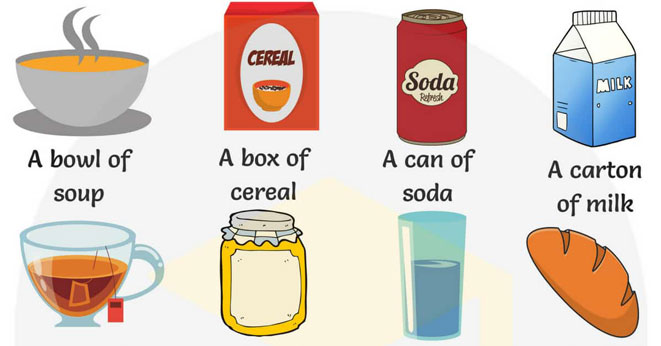Partitives

- Article graphics | Credit 7ESLOpens in new window
Understanding the Uses of Partitives
PARTITIVES are multiword expressions containing a count noun + of (e.g., “loaf of,” “piece of,” “cup of,” “liter of”, etc.) that indicate a unit by which a following head noun can be counted.
Because the count noun in a partitive expression (e.g., loaf, piece, cup, litter ) denotes a unit by which a following head noun can be counted; partitives are therefore considered to be a kind of QuantifierOpens in new window.
Partitives are always preceded by another determiner, as shown in examples 1a through 1d.
And sometimes the preceded determiner can be an adjective, as shown in 1d).
Note that partitives appear before noncount nouns, as in examples 1a, 1b, and 1e, as well as count nouns, as is the case in example 1c and 1d.
- I’ll have a glass of water.
- I’ll have a loaf of bread.
- I’ll have two pieces of pie.
- I’ll have that slice of cake.
- I’ll have a bowl of your new soup.
Some partitives, such as gallon/liter of, can be applied to any head noun that is a liquid, and partitives such as ton/gram/pound of can be used to quantify anything that is appropriately measured by weight.
Similarly, partitives such as bottle of can be applied to different types of liquids that come in this container (e.g., beer, wine, catsup, milk). In contrast, partitives used to quantify food are more restricted. Portions of baked goods such as cake, pie, pizza, and bread are measured by slices, and only bread is quantified by the partitive count noun loaf.
Certain types of vegetables (e.g., cauliflower, cabbage, lettuce) are quantified by head. Textbooks usually do a pretty good job of introducing the general partitive expressions that apply to noncount nouns (e.g., glass of, cup of, bottle, of, etc.).
NounsOpens in new window are also used in a partitive sense to describe groups of humans and animals. As with the examples in the previous paragraph, some of these nouns can have a broader application, for example, a band of can describe robbers, roving minstrels, and gypsies and a bunch of can describe ruffians, teenagers, and sailors.
Other nouns used in this sense are applied to occupations. Thus, squad and platoon usually define units of soldiers (e.g., a platoon of infantrymen).
The same range of general to more restricted application is found with nouns that group animals.
A herd can be used with most large four-footed animals (e.g., a herd of antelope/cattle/elephants), flock is used for birds, and school is applied only to fish. However, subgroupings of these nouns are species specific. Thus, a group of lions is called a pride, a group of whales is a pod, and a group of quail is a covey.
Other ways of expressing quantification include idiomatic paraphrases of regular quantifiers such as a lot of, lots of, a great deal of, loads of, oodles of, plenty of, a smidgen of, and a tad of
























